
Agathis robusta, commonly known as kauri pine, Queensland kauri (pine) or smooth-barked kauri, is a coniferous tree in the family Araucariaceae. Although sometimes called a pine it is not a true pine, having leaves rather than needles. It has a disjunct distribution, occurring in Papua New Guinea and Queensland, Australia. Populations in Papua New Guinea may be treated as the distinct species Agathis spathulata.
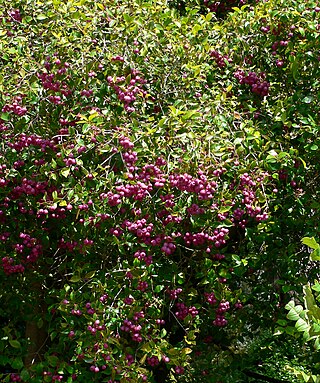
Syzygium smithii is a summer-flowering, winter-fruiting evergreen tree, native to Australia and belonging to the myrtle family Myrtaceae. It shares the common name "lilly pilly" with several other plants.It is planted as shrubs or hedgerows, and features: rough, woody bark; cream and green smooth, waxy leaves; flushes of pink new growth; and white to maroon edible berries. Unpruned, it will grow about 3–5 m (9.8–16.4 ft) tall in the garden.

Allocasuarina torulosa, the rose she-oak or forest oak, is a tree which grows in sub-rainforest of Queensland and New South Wales, Australia. There, it is typically found on coastal footslopes, hills, and plains. Originally described as Casuarina torulosa by William Aiton, it was moved to its current genus in 1982 by Australian botanist Lawrie Johnson. It is the type species of the genus Allocasuarina.
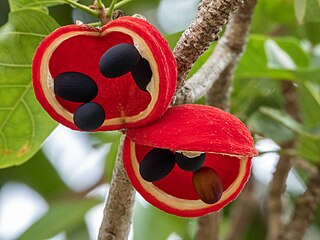
Sterculia quadrifida, also known as the peanut tree, monkey nut or red-fruited kurrajong is a small tree that grows in the rainforests, vine thickets, and gallery forests of New Guinea and northern Australia.

Lophostemon confertus, is an evergreen tree native to Australia, though it is cultivated in the United States and elsewhere. Common names include brush box, Queensland box, Brisbane box, pink box, box scrub, and vinegartree. Its natural range in Australia is north-east New South Wales and coastal Queensland but it is commonly used as a street tree in Sydney, Melbourne, Perth and other cities in eastern Australia.

Neolitsea dealbata, also known as white bolly gum, hairy-leaved bolly gum, or simply bolly gum, is a shrub or small tree in the laurel family Lauraceae which is native to New South Wales and Queensland in Australia.

Macadamia integrifolia is a small to medium-sized tree, growing to 15 metres in height. Native to rainforests in south east Queensland and northern New South Wales, Australia. Common names include macadamia, smooth-shelled macadamia, bush nut, Queensland nut, Bauple nut and nut oak.

Semecarpus australiensis, commonly known as the tar tree, native cashew, marking nut, or cedar plum, is a species of tree in the cashew, sumac and mango family Anacardiaceae, native to parts of Melanesia and northern Australia. Contact with the plant can cause serious allergic reactions, a common characteristic of this family.

Beilschmiedia obtusifolia is a rainforest tree in the laurel family Lauraceae, found in rainforests of eastern Australia and also in New Guinea. In Australia it ranges from Port Macquarie in New South Wales northwards to Cape York Peninsula in Queensland, within tropical and sub tropical rainforests, usually on the more fertile basaltic sites, but sometimes close to the sea. Its common names include blush walnut, hard bolly gum, and nut wood.

Elaeocarpus bancroftii, commonly known as Kuranda quandong, Johnstone River almond, ebony heart, grey nut, or nut tree is a large rainforest tree in the family Elaeocarpaceae which is endemic to Queensland. It has coriaceous leaves, attractive white flowers and relatively large fruit containing an edible kernel.

Phaleria clerodendron, commonly known as scented daphne, scented phaleria or rosy apple, is an evergreen tree or tall shrub in the family Thymelaeaceae. It is endemic to the rainforests of north-eastern Queensland, Australia.

Dysoxylum mollissimum subsp. molle, the red bean or Miva mahogany, is a rainforest tree in the family Meliaceae. It occurs in tropical, sub-tropical and littoral rainforests in eastern Australia, as far southwards as north-eastern New South Wales. Also occurs in Malesia and the south-western Pacific Islands. In Australia it is distributed from the Bellinger River in New South Wales in the south, to the wet tropics of north-eastern Queensland. The specific epithet mollissimum is from the Latin, meaning "very soft", describing the soft hairy leaflets. A signposted red bean tree may be seen near the car park of Victoria Park Nature Reserve in north-eastern New South Wales.
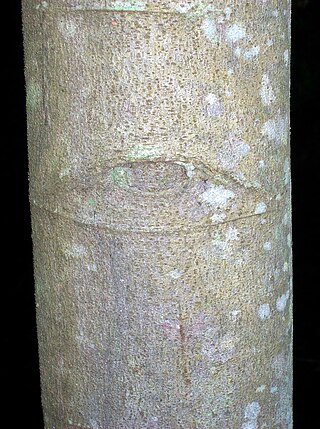
Alphitonia petriei, commonly known as the white ash, is a rainforest tree in the family Rhamnaceae from eastern and northern Australia. Other common names include red ash, white-leaf, pink almond and pink ash. It was originally collected from the Johnstone River in October 1917 by H. Ladbrook, but the designated type for this species was collected by Cyril Tenison (C.T.) White in March 1922 from the Barron River near Kuranda. It was described and named in 1925 by K.W. Braid and White who assigned the species epithet petriei in honour of W.R. Petrie, who alerted them to its distinctness.

Terminalia microcarpa is a tree species in the family Combretaceae. It occurs throughout the Philippines, in parts of Malaysia and Indonesia, Papua New Guinea, possibly the Bismarck Archipelago, and northern Australia. It is cultivated on a small scale in the Philippines, where the edible sweet and tart plum-like fruits are eaten as is or are traditionally made into jams, jellies, and wines.

Tabernaemontana pandacaqui, known as windmill bush and banana bush, is a species of plant in the dogbane family Apocynaceae.

Dillenia alata, commonly known as red beech, golden guinea flower or golden guinea tree, is a tree in the Dilleniaceae family, found in tropical forests of the Moluccas, New Guinea, and northern Australia.

Thomas Lane Bancroft (1860–1933) was an Australian medical naturalist. Based in Queensland, he is known for his research on mosquito-borne diseases such as filariasis, the lifecyle of the Australian lungfish, and new crop varieties.
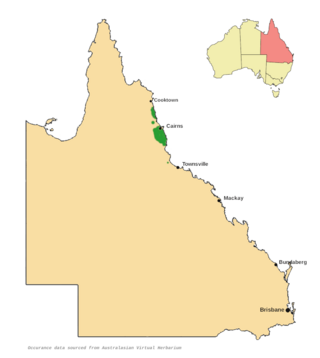
Endiandra sankeyana, commonly known as Sankey's walnut, is a plant in the family Lauraceae endemic to the Wet Tropics of Queensland.
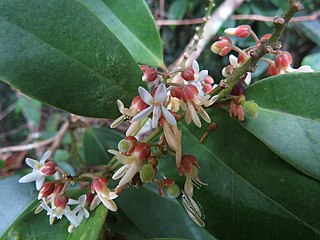
Xanthophyllum octandrum, commonly known as Macintyre's boxwood, false jitta, yellow boxwood or sovereignwood, is a slow-growing tree in the milkwort family Polygalaceae which has the potential to reach thousands of years of age. It is endemic to coastal northeastern Queensland, Australia.

Alstonia muelleriana is a tree in the dogbane family Apocynaceae which is native to southern Papua New Guinea and northeastern Queensland.




















